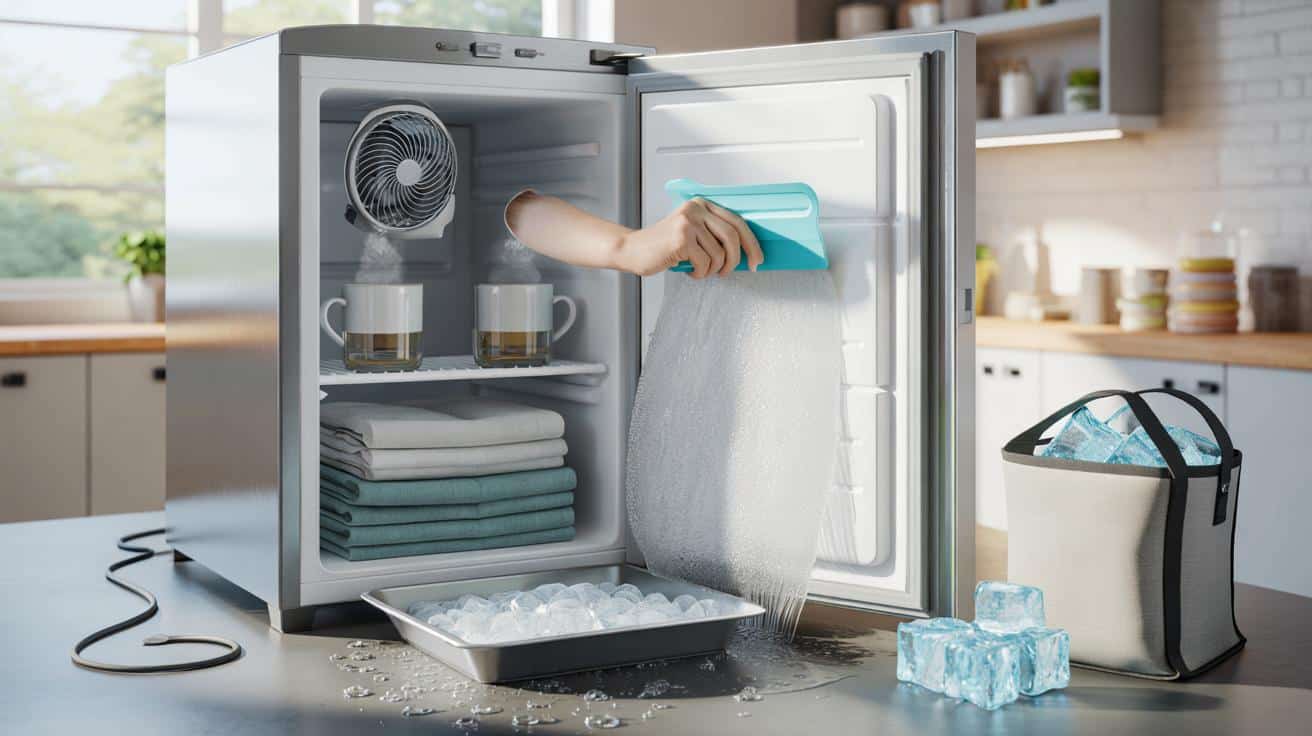That frost looks harmless. It isn’t. It steals space, makes the motor work harder, and pushes up your bill. Good news: you can clear it fast, without a puddle on the floor or panic in the kitchen.
I spotted it on a grey Tuesday, when the peas came out welded into a single green brick. The freezer door had that stubborn tug, like it was holding its breath. A frosty rime had crept over the back wall and around the drawers, whispering: not today. I laid down towels like a stage manager setting the scene, boiled the kettle, set a fan on a chair, and told myself it was a pit stop, not a saga. We’ve all been there, hovering between “I’ll deal with it later” and “Why is my freezer humming like a bus?”. Twenty-five minutes in, sheets of ice slid off with a soft clatter. It felt like getting a room back. There was one trick that made all the difference.
Why fast defrosting pays off
Frost is just water vapour turned stubborn, but it’s costly stubborn. A few millimetres of build-up can force the compressor to run longer, stealing efficiency and nudging up energy use. That’s not just theory; you hear it as a deeper, longer hum and see it on your bill over time.
Space matters, too. Frost narrows drawers, buries labels and traps bags to the wall, so you end up buying doubles because you can’t see what’s there. Let’s be honest: nobody actually does this every week. You wait until the ice wins a little, then you pay for it in wasted food and aggro.
The science is simple. Frost is an insulator, so it blocks the cold air from reaching food evenly, and the thermostat has to call for more cooling to hit -18°C. Studies suggest even a thin layer can add 10–30% to energy use depending on your model and how thick it gets. Little ridge, big cost.
The fast, clean defrost: step-by-step
This is the under-an-hour method that keeps drips under control. Move food into a cool bag with ice packs, or stash it in the garden shed if the day’s chilly. **Unplug before you start.** Pull out drawers and shelves. Line the bottom with old towels and slide a shallow roasting tin beneath the front lip to catch run-off. Boil the kettle, fill two heat-proof bowls with hot (not boiling) water, and place them on upturned mugs inside. Close the door for five minutes. **Steam is your friend.**
Open up and work gently. Use a plastic scraper or silicone spatula to lift loosened sheets; don’t force it. Swap in fresh hot water every 8–10 minutes, and set a desk fan to blow room air across the opening to speed melt and evaporation. Wipe with a hot, wrung-out microfibre cloth between swaps. It’s oddly satisfying when a whole panel sighs off in one clean slab.
If you’re twitchy about puddles, you’re not alone. The stress comes from drips you didn’t plan for, not the melt itself. **No sharp tools, ever.** A knife can nick a coolant line and then it’s game over.
“Gentle heat, moving air, and patience measured in cups of tea — that’s the safe rhythm,” says every good repair veteran ever.
- Keep doors open once unplugged to let moisture escape.
- Rotate hot bowls on a timer so you don’t forget them.
- Wring your cloth into the roasting tin, not the floor.
- Scoop ice slabs into a washing-up bowl to carry to the sink.
Cost-saving tactics that stick
When it’s clean, work fast. Dry every surface with a warm cloth so you’re not seeding new frost. Sprinkle a teaspoon of bicarbonate of soda in a cup at the back to tame odours without perfume. Reset to -18°C; colder doesn’t keep food safer, it just burns money. *Cold is a tool, not a personality trait.*
Load smarter. Keep items bagged and flat, label with a marker, and try to keep it three-quarters full so the cold mass stabilises temperatures. Use a paper-strip test on the door seal: close on a strip and tug; if it slides out easily, the gasket may need a clean with warm soapy water or a replacement. That seal is your silent budget line.
Give air a way to move. Leave a finger’s gap behind the unit and clear any dusty grille with a soft brush and the vacuum once a season. If you notice frost appearing faster than it used to, check for door ajar moments, a wobbly hinge, or warm containers going in. Quick habits here save pounds across the year.
Common mistakes that make frost return faster
Rushing with the wrong tools is the classic. Metal knives, screwdrivers, even a butter knife — all bad ideas. One slip and you puncture a hidden line, releasing refrigerant and turning a cheap job into a replacement. Slow is fast when you’re one nick away from a write-off.
Heat guns and hairdryers tempt people who love shortcuts. They also mix electricity with puddles and plastic that can warp. A small desk fan plus bowls of hot water moves more moisture safely, without scorching liners or seals. Safer, cleaner, calmer.
Another trap is loading back too wet. If you leave beads of water on the walls, you’re basically frost-priming the cabinet. Dry it like you mean it, especially the back panel and shelf rails. A minute now saves an hour later.
How to keep it frost-light, month after month
You don’t need a chore chart. Think tiny nudges. Cool leftovers to room temperature before they go in, and bag food flat so it freezes faster and stacks clean. Open the door with intent, not as a thinking spot. If you see frost ridges appearing on the back panel, make a note on your phone and plan a quick steam session at the weekend. That light touch keeps things easy.
Store a “defrost kit” together: plastic scraper, two microfibre cloths, a couple of old towels, and a shallow tray. Label a box in the freezer for “use this week” so you rotate faster and avoid the archaeological dig. A tidy freezer is quieter, cheaper, and frankly nicer to live with. The sigh you’ll make when the drawers slide like new is worth it alone.
There’s also the bill. A well-set freezer at -18°C, defrosted when frost hits 3–5 mm, and loaded sensibly will use less energy day in, day out. Most UK tariffs hover around pence per kWh; shaving runtime is how you keep your pennies. Small habit, steady payoff.
The no-mess, no-stress groove
Picture the routine: kettle on, bowls in, fan humming, towels down, timer set to ten. Ice lifts, water gathers neatly in the tray, drawers wipe dry, and everything goes back organised with space to spare. You’ve spent under an hour and gained a quieter, cheaper appliance plus a little peace of mind.
Share the trick with a housemate or your mum, and set a reminder for two months out. The next time you open the door, you won’t brace. You’ll just grab what you need and close it with a light click. That’s the goal — less friction, less waste, more calm in the everyday. The tidy hum of a machine that’s on your side.
| Point clé | Détail | Intérêt pour le lecteur |
|---|---|---|
| Prep smart | Towels, shallow tray, hot-water bowls, desk fan | Faster melt, no puddles, less stress |
| Safe technique | Unplug, plastic scraper, rotate hot bowls every 8–10 minutes | Protects the appliance and shortens the job |
| Energy habits | Keep at -18°C, dry surfaces, test door seal, load three-quarters full | Lower running costs and steadier temperatures |
FAQ :
- How often should I defrost a freezer?When frost hits roughly 3–5 mm, plan a quick session. For many homes, that’s every 2–4 months.
- Is pouring boiling water inside safe?Use hot, not boiling, to avoid warping plastic liners. Bowls of hot water and steam are gentler and just as quick.
- Can I use a hairdryer to speed things up?It’s risky near water and can overheat plastics. The fan-and-steam method is safer and surprisingly fast.
- What’s the right freezer temperature?-18°C is the sweet spot for food safety and efficiency. Going colder wastes energy without benefit.
- My door seal looks fine but I get fast frost. Why?Try the paper test and clean the gasket. Also check for warm items going in and long door-open moments that pull in humid air.







